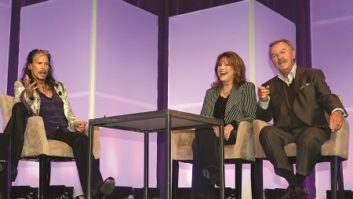With RDS displays becoming commonplace on tabletop and car radios, some broadcasters are looking to do more with this technology.
One of these companies is Emmis Communications, which lobbied Broadcast Electronics to work with Emmis staff and expand the capabilities of its TRE (The Radio Experience) Message Manager software.
The new TRE Message Manager 2.0 can be used to create and then link commercial text messages to specific audio content. Besides ensuring that a listener’s RDS-enabled radio is providing “double duty” to advertisers through unified audio and text messages, MM 2.0 has been configured to be understood by radio traffic managers.

An RDS receiver display Through this BE/Emmis collaboration, “The RDS system software has been revamped to make it work more like a radio commercial scheduling system,” said Jim Roberts, BE’s product manager for datacast systems.
“In our new version, you can create clocks, have avails and integrate messages with various categories. You can also specify how many times the messages will run and tie them to whatever content you want that’s coming out of the playout server.”
Although designed to work with RDS, BE’s software also will export these text messages to HD Radio and the Web.
“The reason we pushed Broadcast Electronics to develop MM 2.0 is because we want to do more creative things with the visual aspects of the dashboard,” said Paul Brenner, Emmis Communications senior vice president and technology officer and an advocate of exploring new ways for radio to use its bandwidth.
“This is a second pathway to the listener that is not being used to its fullest potential. When you connect text messages with broadcast audio, you get a more powerful medium that can do more for your advertisers, your station and your listeners.
“It’s all about sudden impact,” he continued. “For the advertiser, RDS text can reinforce the message that their audio is delivering. For the consumer, the text can offer extra information that catches their attention or helps them out, such as traffic updates. And for the broadcaster, the text can reinforce the station’s call sign and branding.”
(click thumbnail)
A user screen of TRE Message Manager 2.0 from Broadcast Electronics. As for whether messaging could distract drivers, much as cell phones might, Brenner acknowledges the risk but says the responsibility does not lie with broadcasters.
“Some people see the dashboard as a taboo area, because of the risk of distracting the driver. But if the automakers and industry regulators are willing to have a text crawl on their dashboard radios, then we might as well work with it for everybody’s benefit.”
Better traffic
In addition to his work at Emmis Communications — or, more accurately, in line with it — Brenner is president of the Broadcaster Traffic Consortium. As RW has reported, the consortium of several radio organizations is working with NAVTEQ, a provider of real-time traffic data for in-car navigation systems, to export up-to-date, advertiser-supported traffic news to cars via RDS and HD Radio.
“Providing real-time traffic updates to people’s car navigation systems is an effective way to promote the sale of RDS-enabled FM and HD Radio receivers,” Brenner said. “As this application makes its way into more and more cars, other uses can be attached to it; particularly via HD Radio. It’s all about effective use of bandwidth, and using our radio stations to deliver much more than just audio for our listeners and advertisers.”
Radio engineers know the acronym POTS, for plain ol’ phone service. Given the possibilities offered by RDS, HD Radio and the wireless/wired Internets, perhaps traditional radio will soon be seen as PORS, Plain Ol’ Radio Service —audio-only channels delivered to “dumb” receivers with no displays.
“We can see radio doing so much more,” says Brenner. “Why would we want to stick to audio-only, when RDS and HD Radio offer so much potential?”













